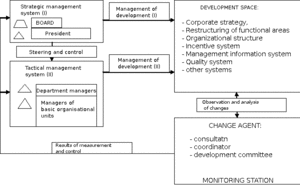Managament of development
It is a system whose goal is to shape the of economic, organizational, personnel, information and technical production development. Its part of strategic and tactical management units.
Business development affects the process of management in such areas as:
- The strategy of the enterprise,
- Restructuring of the company,
- The organizational structure,
- Incentive System,
- Management information system,
- Quality management system etc.
Responsibility for the development lies on leadership on the strategic and tactical level and subordinate organizational units. Management of development is performed by so-called change agents: consultants, coordinators, commissions, workgroups, etc.
The life cycle of the company
The life cycle of company consist of different and distinct forms of development. There are four basic forms of development:
- Pioneering companies
- Growing and expansive companies
- Mature business
- Declining business
Pioneering companies are large and diversified group, which includes the newly established companies and innovative companies. The advantages of such companies include:
- Speed,
- Very good degree of flexibility and adaptability,
- Low cost of organization and management,
- Owner as the "driving force"
- Dominance of innovation and creativity.
In the pioneering period, there are numerous hazards, caused by a lack of experience, low skills, poor self-financing capability and too strong technical approach.
Growing and expansive companies. Grow if business is the development of internal capacity, while the expansion means connecting with other companies by mergers or acquisitions.
Mature companies. During this period, companies have high cash flow, low costs thanks to economy of scale, ability to manage larger resources and know-how and experience in implementing various projects. Although there are also hazards such as waste of resources due to conflicts and power struggles. There are also barriers to innovation and entrepreneurial freedom.
Declining companies Such companies go through a crisis, which threaten viability of business, its market position and ability to generate income. The causes of the crisis may be:
A. External:
- Fluctuations in the demand for a product or service,
- The emergence of new competitors,
- Unfavorable regulations, changes in the political situation.
B. Internal
- Errors in the management,
- Rapid growth,
- Conflicts and power struggles,
- Lack of qualified staff.
The signs of the emergence of the crisis are:
- The use of reserves,
- Outflow of funds,
- Poor motivation,
- Bad attitudes of managers and employees,
- The possibility of bankruptcy of the company.
Tools of business development
The main tools of business management is:
- Programming - sets sequences of company objectives, and then specify the assumptions for their implementation and sets out the stages in the global activity of the company.
- Planning - involves developing programs for distribution of tasks between individual organizational units.
Programs and plans are aimed at restructuring and innovation.
See also:
| Managament of development — recommended articles |
| Cluster development — International corporation — Life cycle of organization — Types of organizational change — Development of the organization — Holding — Examples of weaknesses — Importance of marketing strategy — Business improvement |
References
- Argyris, C. (1971). Management and Organizational Development. The Path from XA to YB.
